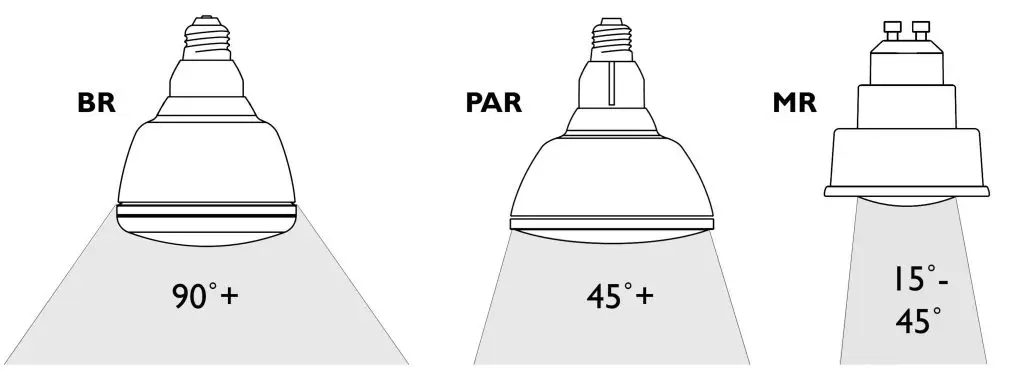Understanding common light bulb shapes, sizes, and styles is important whether you’re converting outdated incandescent fixtures into energy-efficient ones or using LED bulbs for new-construction applications. Every light bulb has identifying characteristics that are represented by a letter or series of letters and a number; these are known as light bulb codes.
The Ultimate Guide to PAR and BR light bulbs
We get it, not everyone is a light bulb expert. It’s fairly simple, after all. You screw it in and expect it to omit joyous light into the intended room or area. Although PARs and BRs sound fairly similar, they have both many differences and similarities. This guide will help you to understand the primary differences and best applications for each bulb in a respective setting.
What does PAR and BR and MR stand for?
PAR stands for “parabolic aluminized reflector” and is best used in settings that require a focused, narrow beam of light. Most PARs do not exceed a beam angle of 45 degrees in most cases. BR stands for “bulged reflector” and is considered a wide-angle floodlight often exceeding 100-degree beam angles. MR means “multi-faceted reflector” and the most narrow of the bulb types mostly used as a spotlight.
What’s the main difference?
The primary difference between the three bulbs aside from the internal engineering is really just the angle of the beam. See the example below:

Size comparison of PAR vs BR floodlights
It’s actually even easier grasp than you might think. The difference between a BR20, BR30, and BR40 is actually the size or diameter of the light bulb. The number represents increments of an 8th of an inch. For example, a BR30 is 30/8ths of an inch or 30 divided by 8 which equals 3.75″ in diameter. The same example applies to a PAR38. Divide 38/8ths of an inch or 38 divided by 8 which equals 4.75″ in diameter. Check out the comparison chart below. Don’t worry… we’re visual learners too.
PAR comparison chart
| PAR38 | PAR30 | PAR20 | PAR16 | |
| Image |  |
 |
 |
 |
| Size |  |
 |
 |
 |
| Brightness | 1200 – 1400lm | 800 – 1100lm | 500 – 700lm | 300 – 400lm |
| Watts | Incandescent – 75W CFL – 35W LED – 15W |
Incandescent – 65W CFL – 22W LED – 9W |
Incandescent -40W CFL – 15W LED – 7W |
Incandescent -35W CFL – 8W LED – 4W |
BR comparison chart
| BR40 | BR30 | BR20 | |
| Image |  |
 |
 |
| Size |  |
 |
 |
| Brightness | 1200 – 1400lm | 800 – 1100lm | 500 – 700lm |
| Useage | Incandescent – 75W CFL – 35W LED – 15W |
Incandescent – 65W CFL – 22W LED – 9W |
Incandescent -40W CFL – 15W LED – 7W |
Are there color differences between PAR and BR bulbs?
No, there are no intrinsic color differences between PAR and BR bulbs other than the actual color you’re purchasing. Think of it like clothes… the same clothes might be available in an array of different colors. Light bulbs are no different. All PARs and BRs can be manufactured in any color. The most common colors are soft white and daylight. Warm or soft white (2700K – 3000K) is typically more suitable for home use in the family and bedrooms. Daylight (5000 – 6500K) is more often used to light kitchen areas. See below the Kelvin scale that illustrates the range of colors available. Learn more about color from Energy Star.

Lighting and Application
PAR bulbs are used in a wide vriety of applications due to their more narrow beam angle. Common uses include (indoor/outdoor) security lighting, theatre, performance sets, spot-lighting signs and can be used in some restaurant applications as well. BR lights are most commonly used indoors in household ceilings with recessed cans. These can be seen most often in kitchens, family rooms, and stair lighting with high ceilings. The broad beam angle allows for a less concentrated light offering better coverage and eliminating shadows in the intended area.
Reference source:



